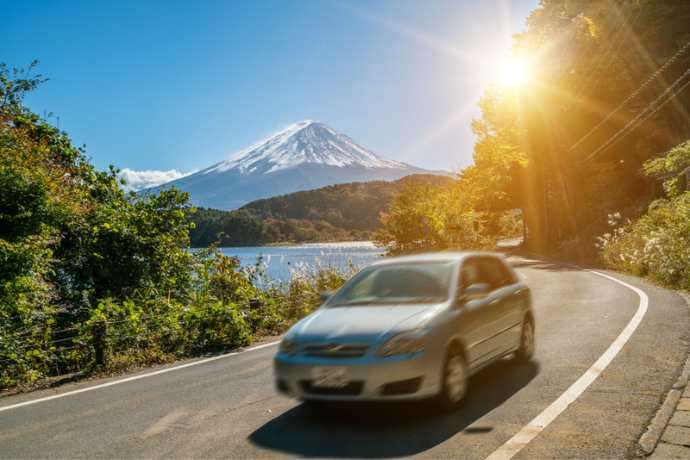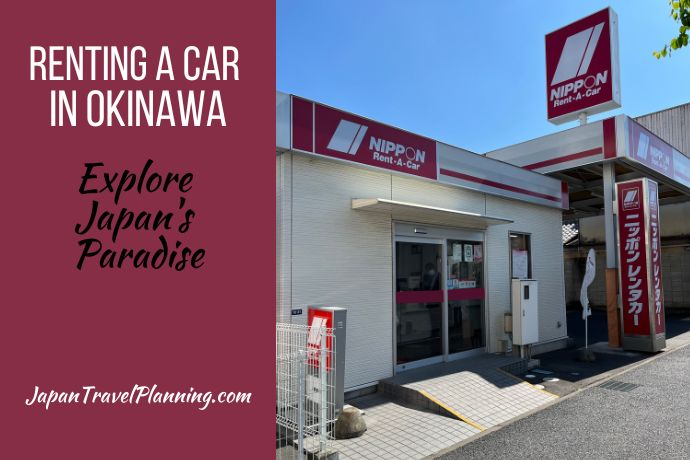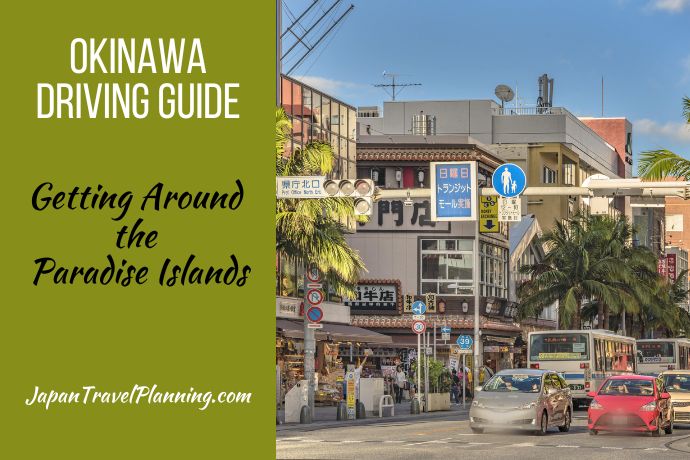Okinawa is best explored at your own pace. The key to unlocking a great holiday? Renting a car in Okinawa.
From my experience, while the idea of navigating Japan’s road rules might seem daunting, Okinawa is an ideal starting point, especially for foreign visitors. The driving is easy, and it’s a great way to get around.
The car rental process in Okinawa is straightforward, and the locals? Well, they’re far more relaxed behind the wheel than on the mainland.
In this guide, I’ll discuss the advantages and disadvantages of vehicle rentals in Okinawa and then explore alternative transport options. I will look into reservation timing, rental rates, and vehicle variety. I’ll introduce you to prominent rental agencies and their locations. Finally, I will outline the car rental and return processes, concluding with answers to common queries about car hiring in Okinawa.
Disclaimer: This article contains affiliate links. If you book after clicking on one of these links then we may receive a small commission at no extra cost to you.
- Easy comparison of multiple car rental provider options using Klook, DiscoverCars or RentalCars
- TooCoo! is a local Japanese car comparison site that has the most options available
- Clear description of included protection and excess
- Good cancellation options
- Child seats, GPS, electronic toll cards, second driver and more are available as add-ons
The Pros and Cons of Renting a Car in Okinawa
While navigating Okinawa without renting a car is possible, doing so offers significant advantages. However, there are also a few downsides to consider.
Advantages of Renting a Car in Okinawa
There are many situations why renting a car in Okinawa makes a lot of sense:
- Flexibility – With a car, you can go whenever and wherever you like. You don’t have to stick to the schedule of an organised tour, and you can stop wherever you want (including for toilet breaks).
- Accessibility – Public transport might not cover all the tourist spots or remote areas you want to visit.
- Saves time – Buses won’t always take the most direct route. You can take the quickest way or a scenic route with a car. Public transport might run infrequently, particularly in rural areas of Okinawa.
- More storage space – A car has more room than a tour bus, which is great if you have bulky things like surfboards, mountain bikes, or strollers.
- Saves money (for larger groups) – For larger groups (use five or more as a guide), rental cars can be more cost-effective than other types of transport.
Driving yourself also lets you see things on your own, although it is easy to be distracted. Okinawa is in every way as pretty as Hawaii (there may be even more flowers).

Downsides to Car Rental in Okinawa
While the benefits outweigh the negatives, there are disadvantages to renting a car in Okinawa.
- Need to invest time in route planning – You must work out what you want to see and do, then research your route well (e.g. using Google Maps). For many people, this is part of the fun of travel. A tour could be a better option for people who want to plan less.
- Cost (for smaller groups) – If you’re travelling alone or in a small group, the car rental, gas, tolls and parking costs can quickly add up.
- Risk of accidents – The risk of accidents is low but possible. Accidents can be caused by lack of familiarity with local traffic rules and signs, road conditions (such as narrow or wet roads, strong winds or debris), driving under the influence or being distracted.
Other Transport Options in Okinawa
Okinawa leans heavily towards cars for transport, particularly outside Naha.
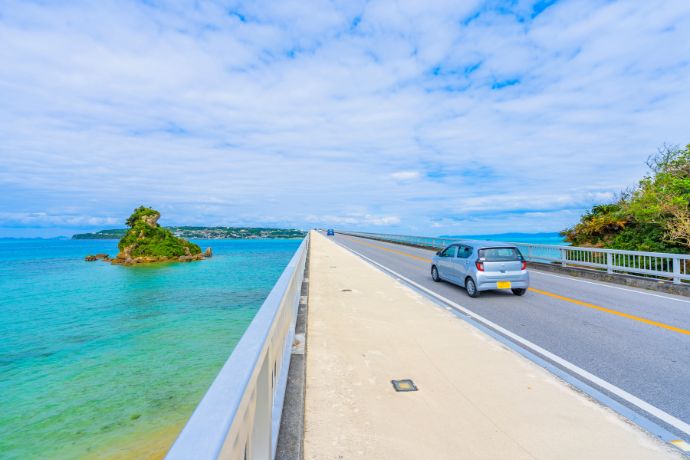
However, there are plenty of other options. In this section, we’ll look at the pros and cons of different transport options.
Private Driver
A good private driver will act as a guide. They discuss your interests and can match them with things to do in Okinawa. They will also work out the best ways to get to places. This option is more expensive and may not work well with extended activities like mountain biking, hiking or surfing.
Tour buses
Tours are less expensive than a private driver, depending on group size. You can also quickly see the bucket list of Okinawa sights and experiences. However, you will lose flexibility and may spend less time at sites than you would like.
Taxis
Taxis are convenient as they provide door-to-door transport. They’re also quite flexible as you can choose your schedule. However, taxis can be costly for longer distances. There might be language barriers. They are less available in rural areas and aren’t efficient if you hire a taxi at each location.
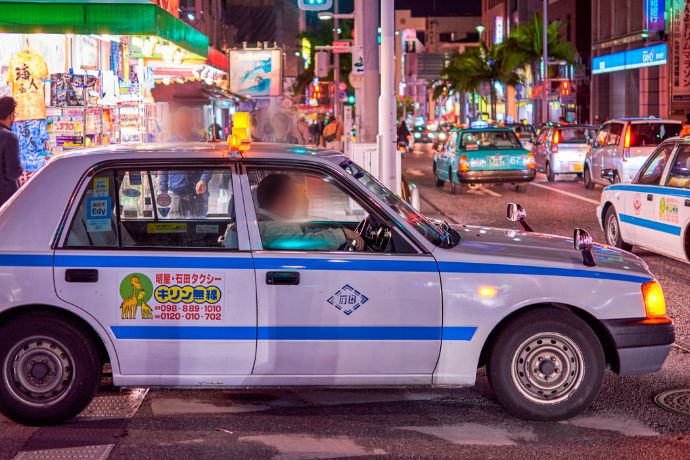
Sightseeing taxis would be a good option to consider. They are a quick and convenient transport option. Sightseeing taxi drivers will be more knowledgeable guides than regular taxi drivers.
Airport transfer
An airport transfer is a good option if you want to get from the airport to a particular location like a resort.
Buses
Local buses are a cheap and easy way to get around, particularly on the main island. They’re a popular transport choice in the bigger cities. Buses are also quite good for connections to popular destinations. The more rural the area, the more infrequent buses get. Some more remote islands may have bus services.
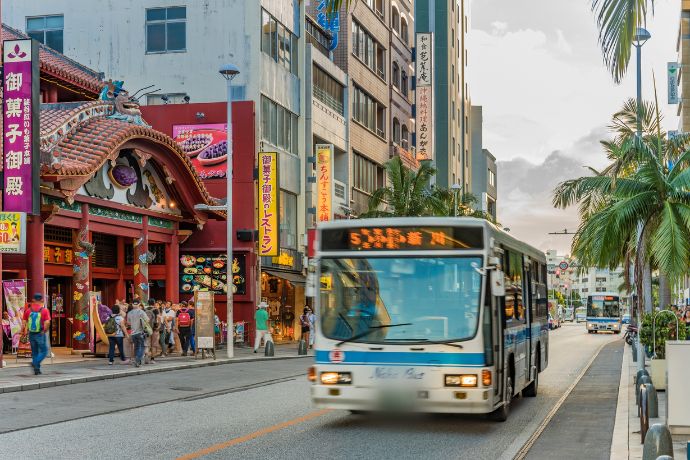
Monorail
Using the monorail is an excellent option, but only in Naha. It’s easily accessible to many sightseeing destinations in Naha, the service runs frequently, and it’s cheap. Expect it to be crowded in rush hour.
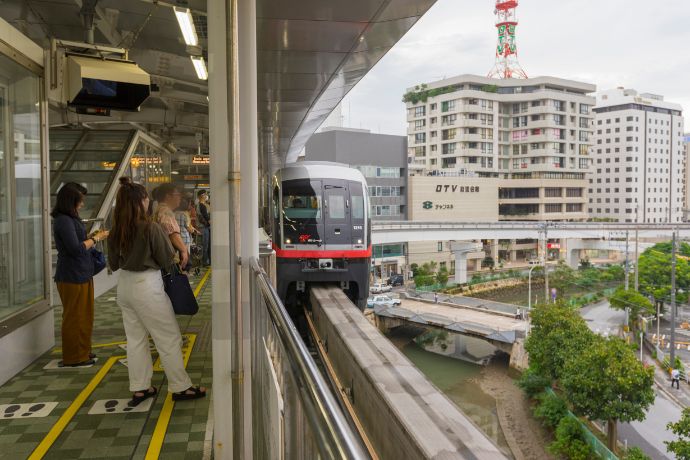
Bike rental
Bike rentals are great for short distances and hands-on exploring. There are also good roads, even in the countryside. They’re not a great choice (for most people) for longer distances or during bad weather.
When to Book Your Okinawa Car Rental
Once you’ve decided to go to Okinawa, booking your car rental in advance is essential, especially if you’re looking for a specific vehicle type. Cars like cabriolets, sports cars, and seven-seaters for families and big luggage can run out quickly. To secure your preferred vehicle type, consider booking three months ahead.
Demand for rentals, especially at Naha Airport, is high throughout the year but peaks during high tourist seasons. Availability drops even more during Japanese and Chinese holidays like the New Year, Golden Week in May, Obon in August, and Silver Week in September. For these times, consider booking up to six months in advance, particularly if you’re after a particular type of vehicle.
The other advantage of booking earlier is that you might be able to secure a better car rental rate.
Car Rental Rates in Okinawa
Rental rates in Okinawa are similar to other places in Japan. Prices vary based on factors such as vehicle type and demand.
As a rough guide, kei cars (the smallest highway-legal passenger cars) will cost about 5,000 yen per 24 hours, family-sized cars will cost about 10,000 yen per 24 hours, and minivans/SUVs will cost around 15,000 yen for a van.
In Okinawa, the demand for rental cars varies throughout the year. You will pay more to rent a car during peak periods. New Year’s, Golden Week in May, Obon in August, and Silver Week in September see a surge in rental prices.
Tourists flock to Okinawa during these times, resulting in higher demand and, consequently, higher rates. It’s important to be aware of these seasonal fluctuations when planning your trip and budget.
Compare options and book your Okinawa rental car through either Klook, TooCoo!, Discover Cars or RentalCars.com.
- Easy comparison of multiple car rental provider options using Klook, DiscoverCars or RentalCars
- TooCoo! is a local Japanese car comparison site that has the most options available
- Clear description of included protection and excess
- Good cancellation options
- Child seats, GPS, electronic toll cards, second driver and more are available as add-ons
The rental rate usually provides basic insurance. You will have to pay extra for collision damage waivers and more comprehensive insurance.
You can rent a vehicle for longer and pay when returning your rental car. Let the rental car company know in advance, as increasing the rental period may only always be possible. The rental outlet may also charge a penalty if you don’t let them know beforehand.
Make sure to return the rental car with a full tank of gas. If you don’t refuel, the rental car company will charge a refuelling fee that may be higher than what you would pay at a gas station.
Types of Rental Cars in Okinawa
Rental cars in Okinawa mirror those found in other parts of Japan. When choosing a rental car, the main factors to consider are the number of passengers and luggage volume.
Rental cars in Japan are usually vans, minivans, SUVs, family cars, compact cars, and sub-contact (kei) cars. Let’s look at the choices more closely from largest to smallest.
Vans
Vans are the largest vehicle type you can readily rent. Such vans carry about ten people. For many people, the International Driving Permit (IDP) will only allow you to drive vehicles with at most eight passengers in addition to the driver. Further, the vehicles cannot exceed 3 500 kg (7 700 lbs) in weight.
In addition to the fact you may not be able to rent one, they have limited luggage space. Older models are typically gasoline-only, and the air-conditioning may not be great.
Minivans and SUVs
Minivans and SUVs seat seven and have considerable luggage space (particularly in a five-seater configuration). They’re a great choice if you have several children. Minivans and SUVs are often available as hybrids for better fuel efficiency. SUVs provide a higher road view but might pose parking challenges due to their size.

Family Cars
Family cars are designed for four to five passengers. They provide moderate luggage space and are generally easier to drive than larger vehicles.
Compact Cars
Compact cars seat four people. If you have taller passengers, they won’t fit comfortably in the back seat.
Kei Cars
Kei cars are the smallest highway-legal passenger cars. The regulations for the kei category specify maximum vehicle size, engine capacity and power output. There are also kei trucks.
Even though the external dimensions of kei cars are small, they can be surprisingly spacious, sometimes having more passenger space than a compact car. Some kei cars have higher driving positions, like SUVs. Newer kei cars often have no problems handling highway speeds.
They are an excellent rental option if you have a small number of people and limited luggage.
Major Car Rental Agencies in Okinawa
Okinawa has a wide array of car rental agencies, with the major players from mainland Japan as well as a number of smaller rental agencies.
The leading agencies include Toyota Rent-a-car, Nippon Rent-a-car, Nissan Rent-a-car, Orix Rent-a-car, and Times Car Rental.
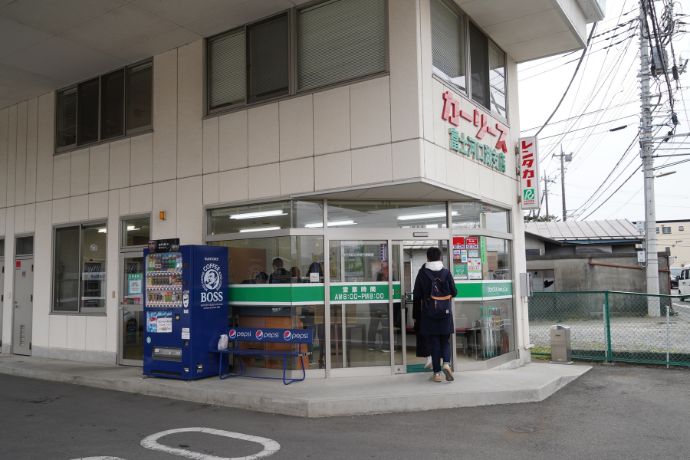
Numerous smaller car rental companies can be found around Naha. They’re a good option, especially in peak times when larger agencies might be fully booked. You won’t need to worry about the quality or availability of cars once you’ve booked, even if they have fewer cars than larger agencies. The easiest way to find them is to look on Google Maps and make a reservation directly.
Naha also has specialised rental agencies like Celeb Car Rental, Select Car Rental, and Heat Sports Car Rental. These are your go-to places for luxury vehicles, including cabriolets.
How to Rent a Car in Okinawa
We will write this.
- Rental Car Aggregators ( Klook.com, ToCoo.jp, Discover Cars or RentalCars.com) – Pros (comparison shopping, deals, and discounts, wide of options, user reviews, one-stop-shop) and Cons (additional fees, indirect communication, limited loyalty benefits)
- Direct booking with a rental car company – Pros (direct communication, loyalty programs, familiarity) and cons (limited comparison, potentially less competitive prices, limited range)
- Walking into a rental car agency – Pros (personal interaction, inspect vehicles, immediate availability, flexibility, not internet dependent) and cons (availability issues, price variability, time-consuming, limited comparison, no prior reviews, possible language barriers, pressure to decide)
Where are the Car Rental Offices Located in Okinawa
If you’re travelling to Okinawa, Naha Airport is the main entry point for most people. The car rental process here is efficient, and many staff members speak fluent English, a benefit from the presence of US military personnel.
The car rental offices are not located directly at Naha Airport but conveniently along National Route 331. This location ensures easy access to the rental offices and the rest of Okinawa Island. Major rental agencies offer dedicated shuttle buses from the airport to their offices. If you’re renting from these agencies, make sure you board the right shuttle.
While many rental agencies have branches around the airport, others operate from various parts of Naha. Outside of Naha are additional car rental offices catering to tourists and service personnel, especially near US military bases.
Despite Naha Airport being the central transport hub, other places to rent a car in the region exist. For example, if you’re visiting outlying islands like Miyakojima or Ishigakijima, you’ll also find rental services there.
Car Rental Process in Okinawa
When making your reservation, give the rental agency your flight details to guarantee your car’s readiness, accounting for possible flight delays.
Depending on how you book and who you book through, you may either pay upfront or when you collect your vehicle.
Renting a car in Okinawa requires specific documents. First, ensure you’re over 18, the minimum driving age in Japan. When arriving at the rental office, you must present your passport and driver’s license.
You must also provide your International Driving Permit (IDP) or an authorised translation of your license for residents of countries like Switzerland, Germany, France, Belgium, Monaco, and Taiwan. Due to the significant presence of US military personnel in Okinawa, SOFA licenses are often accepted as identification.
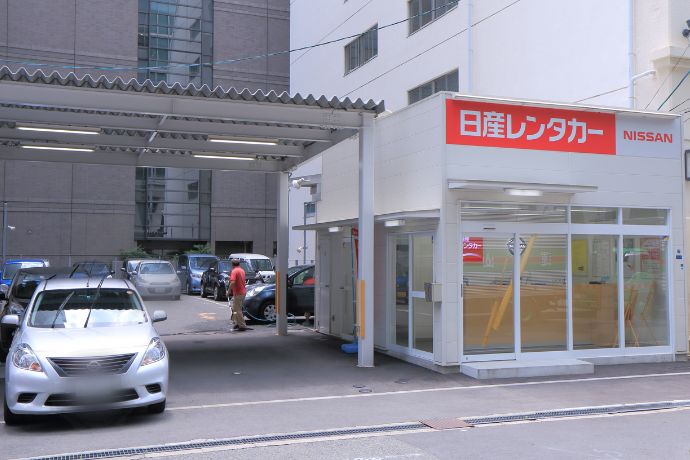
The Pre-Driving Car Check
Conduct a thorough pre-driving check before heading off with your rental car in Okinawa. Even minor damages can result in charges, so ensure the vehicle is in good condition.
Exterior Checks
- Examine the car for scratches or dents. Use your mobile to photograph any exterior damage and report it to the rental agency.
Key Functions
- Check all lights, including headlights, turn signals, and brake lights.
- Adjust and understand the settings of side mirrors.
- Familiarise yourself with dashboard warning lights, particularly the low fuel indicator. Know which fuel type the car needs; remember it by the pump handle colour.
- Confirm the drive recorder works; it’s crucial for accident evidence.
- Understand how the ETC card works if using expressways.
Interior Checks
- Adjust the air and temperature settings. You’ll appreciate them in Okinawa’s tropical climate.
- Know how to modify seat positions, including folding back seats for more cargo space.
- Locate the emergency reflector triangle and ensure the car has one.
- Find the insurance documents and ensure they’re stored where you’ll quickly find them (like the glovebox).
- Check if the car manual is available in English.
Navigation
Japanese car navigation systems can be challenging for non-Japanese speakers. Ensure the GPS is set to English if the navigation system offers multiple languages.
If you can’t change the GPS language to English and are unfamiliar with Japanese, consider using mobile map apps like Google Maps or Navitime. Mobile map apps work well in Okinawa, even if the instructions and information about the next turn could be better.
However, remember that drivers in Japan cannot use mobile phones while driving; have a passenger navigate if necessary.
Driving Around Okinawa: What to Expect
With its well-maintained roads and pleasant weather, Okinawa offers a driving experience often superior to other parts of Japan. Moreover, finding parking in Okinawa is generally easier.
Most major roads and highways in Okinawa are in excellent condition. However, you might encounter narrower roads when venturing into rural areas or smaller islands, so extra caution is advised. The local drivers are generally courteous.
Refuelling is straightforward, similar to the rest of Japan. While there are ample petrol stations in southern Okinawa Island, they’re less frequent in the north and on the Yaeyama and Miyako islands.
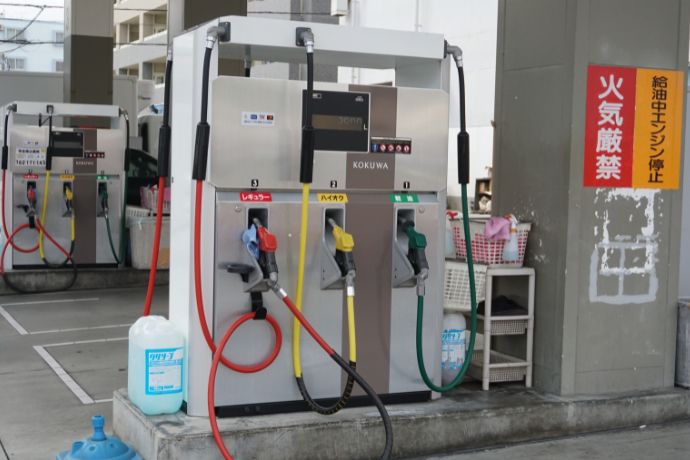
Familiarise yourself with Japanese road rules before setting off. Learn about the most critical road signs, such as the stop and speed limit signs. Also, remember that Japan drives on the left. Switching from right to left-hand driving can be challenging, but most people adapt quickly.
Remember to rest before driving if you’re jet-lagged after a long journey. Driving in Japan can be demanding, and it’s best approached when you’re alert and refreshed.
Returning a Rental Car in Okinawa
Before dropping off your rental car in Okinawa, here’s what you need to do to ensure a smooth return process:
Preparation
- Refuel – Refill the car with the recommended fuel type. There are several gas stations near Naha airport. Choose the closest gas station as possible to the rental car agency.
- Clean the Car – Washing the car isn’t mandatory, but avoid returning it muddy or excessively dirty. Inside, discard any rubbish and clean noticeable spills or stains.
- Personal Belongings – Remove all items from the car. For families, double-check to prevent any child’s treasured toy from being left behind. Check that essential documents like passports and driver’s licences are with you.
- Document Issues – If the car has new dents, scratches, or other issues, photograph them. For minor functional problems that don’t require immediate repair, make a note to inform the agency.
At the Rental Agency
Drive to the return location and hand over the keys. The agent will inspect the car. If the vehicle has any pre-existing minor scratches, your previously taken photos will be handy.
After the return and inspection, you’ll need to pay any outstanding charges.
- Easy comparison of multiple car rental provider options using Klook, DiscoverCars or RentalCars
- TooCoo! is a local Japanese car comparison site that has the most options available
- Clear description of included protection and excess
- Good cancellation options
- Child seats, GPS, electronic toll cards, second driver and more are available as add-ons
Frequently Asked Questions about Renting a Car in Okinawa
Renting a car can be the key to unlocking some great experiences in Okinawa. We’ve answered some of the most commonly asked questions to help navigate you through the Okinawa car rental process.
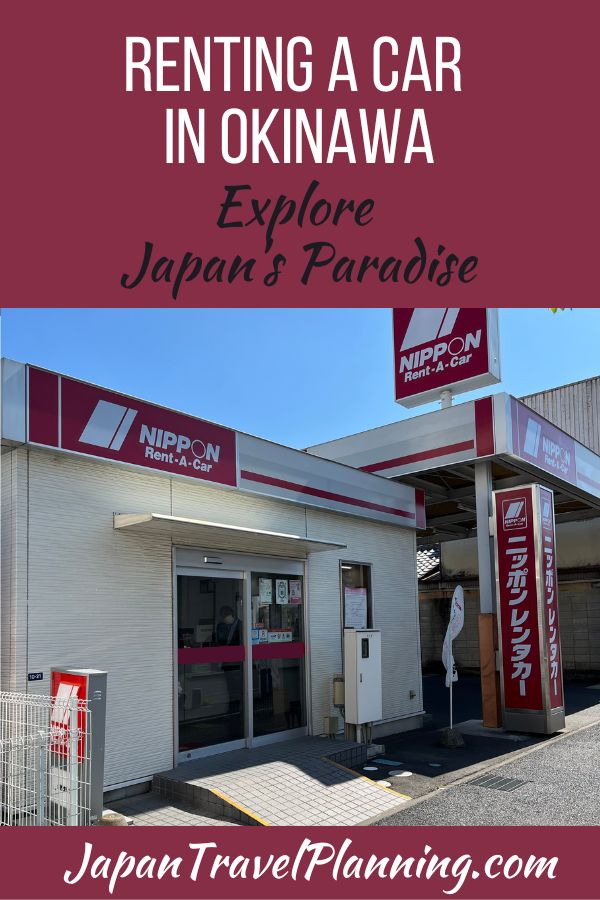
You may also like:
Renting a Car in Okinawa: Explore Japan’s Paradise
Driving in Okinawa Guide: Getting Around the Paradise Islands
25 of the Best Things to Do in Okinawa: The Perfect Blend of Relaxation and Adventure
Join the Japan Travel Planning Facebook Group or Discord Server
You are also welcome to join our Japan Travel Planning Facebook Group and our Japan Travel Planning Discord Server – they are great resources to enable you to ask questions about your upcoming trip to Japan!
Disclaimer: This article contains affiliate links. If you book after clicking on one of these links then we may receive a small commission at no extra cost to you.

